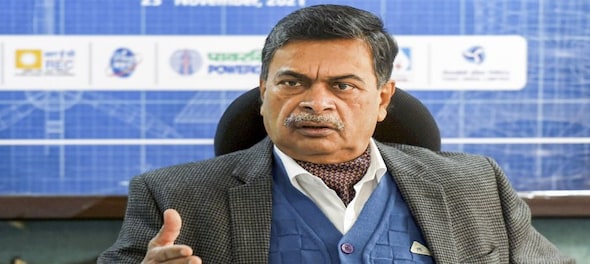
Union Minister for Power and New and Renewable Energy, RK Singh has said that the government is planning to promote renewable energy by enabling power sale to power exchanges once the RE capacity has been set up.
Unveiling the Union Government's plans for transmission system to integrate renewable energy capacity of over 500 GW by 2030, Singh said that the plan envisages a battery storage of 51.5 GW by 2030 as renewable energy is available only for a limited period during a day and energy storage will be crucial in the path for transition to renewables to maintain the base load on the grid.
The planned Battery Energy Storage Capacity is expected to provide round-the-clock power to end consumers.
Also read: Private sector capex intentions rise significantly but real capex cycle yet to pick up, say analysts
Speaking in presence of the Ministers of State and Secretaries for Power and New and Renewable Energy, the Union Minister said that the government is thinking of allowing power sale to power exchanges after the capacity has been set up.
With the power demand expected to expand with growth in jobs in the secondary and the tertiary sectors of the economy, he reiterated that even a short term dip in profits in the power sector won't deter the government from proceeding with energy transition and capacity addition.
The plan aims at 537 GW of RE capacity by 2030 for the transmission system, along with an addition of 500 GW of non-fossil fuel energy to the additional transmission systems at an estimated cost of Rs. 2.44 lakh crores.
The systems include 8120 circuit kilometres (ckm) of High Voltage Direct Current Transmission corridors (+800 kV and +350 kV), 25,960 ckm of 765 kV AC lines, 15,758 ckm of 400 kV lines and 1052 ckm of 220 kV cables.
The inter-regional capacity is slated to rise to 1.50 lakh MW by 2030 from the current 1.12 lakh MW as per the plan, which also includes a transmission system required to evacuate 10 GW off-shore wind in Gujarat and Tamilnadu at cost of Rs. 0.28 lakh crores.
The Plan has identified major upcoming non-fossil fuel based generation centres across India: including Fatehgarh, Bhadla, Bikaner in Rajasthan; Khavda in Gujarat; Anantapur, Kurnool RE Zones in Andhra Pradesh; offshore wind potentials in Tamil Nadu and Gujarat and an RE park in Ladakh.
The projected transmission system is expected to provide visibility to RE developers on potential generation sites and scale of investment opportunity, along with an investment opportunity of Rs. 2.44 lakh crore to Transmission Service Providers.
India plans to have 500 GW of non-fossil fuel based electricity installed capacity by 2030, and aims to make cleaner fuel comprise 50 percent of the installed capacity mix by 2030. The current installed power generating capacity in India is 409 GW, which has 173 GW (around 42 percent) from non-fossil fuel sources
Check out our in-depth Market Coverage, Business News & get real-time Stock Market Updates on CNBC-TV18. Also, Watch our channels CNBC-TV18, CNBC Awaaz and CNBC Bajar Live on-the-go!


Lok Sabha elections 2024: 28% of candidates contesting in fourth phase are 'crorepatis'
May 9, 2024 4:29 PM
Free poha-jalebi to movie ticket discounts: How cities struggling with 'urban apathy' are luring voters to polling booths
May 9, 2024 3:17 PM

